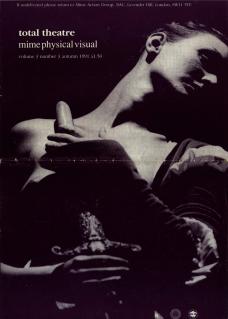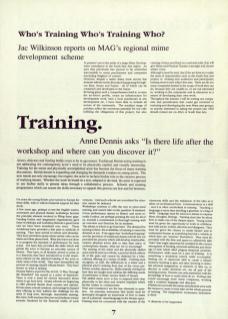Actors, directors and funding bodies seem to be in agreement: traditional British acting training is not addressing the contemporary actor's need to be physically explicit and visually interesting. Training for the mime and physically accomplished actor has become the focus of many training discussions. British theatre is expanding and changing the demands it makes on young actors. The new trends not only encourage, but require, the actor to reclaim his/her role in the creative process of realising theatre. Whether the work be based on a text, adapted or devised, the actor is expected to use his/her skills to present ideas through a collaborative process. Schools and training programmes which can ensure the skills necessary to support this process are few and far between.
For years the young British actor turned to Europe for these skills, with or without financial support for their study.
A few years ago, perhaps to test the English waters, movement and physical theatre workshops became the principle element involved in filling these gaps. Funding bodies and imaginative organisations gave these workshops and workshop festivals a great boost and we have been inundated ever since. These workshops have provided a first taste in methods of training. They have served to inform and stimulate. They have provided a space where artistic risks can be taken and ideas played with. What they have not done is to progress the standard of performance for most actors. Nor have they provided the skills which will permit the actor to become an articulate creator of theatre. They have, in all fairness, served to point us in a direction; they have introduced us to the importance placed on the physical training of the actor in many areas of the world. They have demystified the process of creating visually vibrant theatre. They have shown us what is lacking.
Naseem Kahn's report for the ACGB, ‘A Way Through the Mimefield’ has served as a point of departure. There is now a need for serious discussion about where to go from here. Drama schools are beginning to offer physical theatre short courses and options. Private mime schools continue, and manage to expand their offering as they address the challenge for the need of long term, thorough, responsible training. But, here, both teachers/directors and students remain severely hindered by the financial reality of such ventures. Until such schools are accredited the situation cannot be bettered.
Workshops continue to offer the way to piecemeal training, and cannot take on the question of standard. Circus performance spaces in Bristol, and more recently London, are perhaps pointing the way for all of us, towards a commitment to thorough training with an overview and direction for its students.
The debate is where to go from here. The demand for training is there: the availability of training to meet this demand, is not. If we agree that ‘workshop-hopping’ and the provision of traditional drama schools has not provided the process which will develop employable, creative physical actors able to take their place in contemporary theatre, what are we to encourage? The training of the mime and the physically skilled actor must be seen as a whole, a process which reflects all of the parts and cannot be obtained by a bitty, cafeteria offering of a variety of skills. Training must recognise, as well, the differences in a mime and a physical actor's training from that of the circus performer, acrobat, dancer etc. Skills certainly overlap but how they are taught must address the differing needs of performers in these various fields of theatre.
The skilled mime actor is free to respond with clear physicality to the ideas and creative impulses which he/she wishes to communicate.
Time and consistency are the key elements in question. An articulate instrument (the body) must be developed alongside an awareness of how to make use of a physical, visual language in the theatre space. Training must be concerned with the transfer of the classroom skills and the realisation of the idea as it takes on its theatrical form. Communication is a skill – and it is often overlooked in training. Teaching a language is more than teaching a grammar or a bag of tricks. Language must be used as a means to express ideas, thoughts, feelings. Training must also be about how to make use of the theatre space. Young actors must be given the opportunity to work in collaboration with actors, writers, directors and designers. They must be given the chance to create theatre and to understand theatre as something beyond a vehicle in which they can ‘express’ themselves. They must be provided with the time and space to collectively take ‘risks’ that might otherwise be curtailed in the current atmosphere of funding, personal ambitions and shortage of time which often plagues theatrical creativity. Performance skills must be a part of training. It is something a workshop cannot really accomplish. Making use of classroom skill to create a theatre moment; learning to give and take; learning to stimulate physical imagination, to research, to take on, to discard, to make decisions, etc, are all part of the training process. Dreams can only materialise with the knowledge of how to make them do so. Perhaps this would encourage more mime companies, working with a common language and direction.
If Britain is to provide the mime and physical actor with the means to create it must take on the whole process of training. The imagination, excitement, dedication is there.
It deserves to be supported.

